If you’re considering applying to an Executive MBA program, you’ve probably heard the words “Executive Assessment” from fellow applicants or program alumni. There isn’t a lot of information out there about the GMAC Executive Assessment, so we decided to put together a beginner’s guide.
Our beginner’s guide assumes you don’t know anything about the MBA admissions test: the GMAT. Many of the guides we have seen explain the Executive Assessment in reference to the GMAT. That is fine, if you have already researched the GMAT. If you haven’t, read on to find out more about the GMAC Executive Assessment from a beginner perspective.
Table of Contents
What is the GMAC Executive Assessment (EA)?
The Executive Assessment is an exam launched in 2016 by the Graduate Management Admissions Council (GMAC), the makers of the GMAT. The EA was developed as an admissions test specifically for Executive MBA programs.
Prior to 2016, if you wanted to apply for an EMBA program, you had to take the GMAT (the standard admissions test for traditional MBA programs). Only, preparing for the GMAT is months of work. It’s also normally taken by MBA applicants who have been out of school for only a few years, not more than a decade, as EMBA applicants typically have.
Most importantly, EMBA programs care more about the quality of your work experience and success as a leader than your ability to do geometry.
The result?
Many EMBA programs began to waive the GMAT as a requirement or develop their own admissions tests. The clear need for a revised admissions test for EMBA programs led the GMAC to develop the Executive Assessment.
Why Take the GMAC Executive Assessment?
The Executive Assessment is specifically designed for “seasoned professionals” who are applying to Executive MBA programs around the world.
Here’s why Chicago Booth requires it:
Your chosen EMBA program will let you know which admissions test to take. Typically, they will include a blurb about the EA, like this one from Boston University, if they recommend it over the others.
If you are given the option to take the GRE, GMAT or EA, take the EA. It is shorter, more focused, and simpler to prepare for than the GMAT (more on this later).
Accepted by Many Executive MBA Programs
As of January 2020, more than 90 business schools–including some of the best in the world–accept the EA as an admissions test.
Check here to ensure that your program is on the latest list.

Not Everyone Accepts the EA, But They Might
But what if your program isn’t on the list?
Ask the admissions officer if they will accept the GMAC Executive Assessment. Depending on your experience and compatibility with the EMBA program, the admissions committee may decide to accept your score or waive the admissions test requirement altogether.
If the program says no, you are still free to apply to other programs or jump through the hoop of taking the GMAT.
Want to get the admissions officers so excited about you that they can’t wait to receive your application? We’ll tell you the strategy we follow with our students in this free 7 day Executive MBA Strategy Course.
Free 7 Day Executive MBA Strategy Course
Want to know how to get into any Executive MBA program? Take our free 7 day email course to learn a proven strategy, complete with tips, examples, homework and more. Sign up now to start the course today.
GMAC Executive Assessment Overview
Now that you know what the EA is and why you should probably take it…
What exactly is on the exam?
Exam Structure
There are 3 sections on the exam, each with different types of questions:
- Quantitative Reasoning Section (“the math”)
- Verbal Reasoning Section (“the reading”)
- Integrated Reasoning Section (a bit of both)
Each section is 30 minutes long, making the entire EA a 1.5 hour test. Here’s the test order and how GMAC describes each section.
Source: Graduate Management Admission Council
Multistage Adaptive Design
The EA is a multistage adaptive test. As a MAT, the EA changes the level of difficulty of the section based on how well you did on the previous section. Therefore, the first section is always a medium level of difficulty. The next one will be harder or easier based on how you did on the first one.
If you continually proceed up the more difficult path. your score will be higher because you got more right. Conversely, the less difficult path leads to a lower score.
Here’s how GMAC explains it:
Source: Graduate Management Admission Council
The best strategy for addressing the multistage adaptive nature of the EA?
Be sure you are studying for the Integrated Reasoning (IR) and Verbal Reasoning sections as much as you are the Quantitative Section.
We’ve seen students spend an exceptional amount of time on “the math” because they thought it was more important, only to end up with a low total EA score because they did only basic practice for the verbal and none for the IR.
The lack of study for IR is especially prevalent with students who use old GMAT materials to study for the EA. The IR section is not included in the total composite score for the GMAT, so many prep companies have not spent time developing strategies and materials. The IR section is included in the total composite score for the EA, so you have to be sure to spend time studying for this equally important section.
Since the IR and verbal sections come before the quant, you will already be on a certain scoring path before you get to the math, if you haven’t studied for all three.
Other advice?
Don’t worry to much about the adaptive nature of the test. We have had students who thought they got an easy verbal section (which meant they did poorly on the IR) and panicked, then bombed the quant. Perhaps, they were just so prepared it all seemed easy.
Prepare properly and you’ll be fine.
Skipping, Going Back, and Changing Answers
One benefit of adaptive testing the way it is done on the EA is that you can skip, go back, and change answers with the SAME GROUP of questions.
Here’s GMAC’s description of the process:
Source: Graduate Management Admission Council
How can the review screen help you?
For the IR and Verbal sections, you can use the review screen to previous the section. Basically, you put any answer just to see how many subquestions are on the IR or if there is a reading compreprehension passage in the module. Both of these types of questions take more time and have connected parts.
However, it is risky to preview the module because you might accidentally not change a wrong answer or go to the next module. Use the preview strategy on the IR and Verbal at your own risk.
For the quant, you should be so well studied that you don’t need to go back or change your answers, but it is nice to know that you can.
GMAC Executive Assessment Format by Section
Now that you understand the test structure as a whole, here’s more about what’s in each of the three sections.
Integrated Reasoning Section
The first section on the classic EA is Integrated Reasoning. This section is probably the most similar to your actual professional work because it is designed to mirror the type of analysis many business people do on a daily basis. Think of it as a mixture of math and reading.
The four Integrated Reasoning question types are:
#1 Graphics interpretation: answer questions based on a graph or figure
#2 Two-part analysis: use given information to answer related questions
#3 Table analysis: answer questions based on a sortable table
# 4 Multi-source reasoning: use different written and graphic sources to answer questions and draw new conclusions
Each IR question has multiple parts that test your ability to interpret charts, tables, and graphs as well as combine your conclusions with written information. In total, you may have between 24 and 36 sub-questions to answer.
You will see many different answer types depending on the question: fill in the blank, true/false, yes/no, and multiple choice.
You only have 30 minutes to answer 12 questions, so you have to work quickly.
The IR section is tricky because it combines quantitative and verbal skills. Incorrectly analyze the text and it’s unlikely your math skills will save you. Read a question or passage with full understanding but do the math wrong and you’ll still get the question wrong.
You are allowed to use a calculator on the IR section, but you will find it only moderately helpful. Standard test prep design dictates that all questions should be able to be done without a calculator, so test makers ensure that questions revolve around higher level concepts that cannot be tested by simply punching numbers into a calculator. Often, you have to know what to do long before you pick up your calculator. It’s only there to speed up calculations, not answer the questions for you.
Verbal Reasoning Section
The most underrated section of the EA exam has to be the Verbal Section. Many people like to refer to this one as the “English” but it’s way more than that.
On the Verbal Section, you do more than just read a passage and answer questions or correct sentences. There is a huge logic component built into almost every question.
Remember, this section is not an English language test because the EA is designed, first and foremost, to evaluate native English speakers.
There are three types of questions on the EA Verbal Section and they can pop up in any order:
#1 Reading comprehension: a passage with questions to answer
You will have 3 to 4 questions about the same passage. Fortunately, the passage stays on the screen the entire time and only the questions change. Therefore, you can use the passage to answer the question rather than relying on your memory.
#2 Critical reasoning: logic questions based on statements
Part comprehension, part logically analysis, critical reasoning questions require you to read closely and then apply the GMAC brand (not conventional) of logic. Fortunately, we teach the GMAC brand of logic in our EA Prep Course.
#3 Sentence correction: correct the grammar in the sentence
You are likely to see more sentence correction questions than reading comprehension and critical reasoning questions. Sentence corrections require you to use your knowledge of modern American English grammar and usage to correct the underlined portion of the sentence. However, you must also be able to reason your way through similar possibilities.
Answering 14 questions in 30 minutes would seem easy, but the section includes a fair amount of reading and thinking. In general, practice to two minutes per question and you will adjust to the hurried pace of EA verbal.
Quantitative Reasoning Section
The Quantitative Section is the EA’s math section. Well, math mixed with logic mixed with tricky word problems.
Fortunately, math on the quant section only includes arithmetic and algebra (so no geometry, trigonometry, and calculus). Unfortunately, it’s a deep dive into these seemingly rudimentary mathematical disciplines (absolute value, anyone?).
Although you are allowed to use a calculator on the IR section, you are NOT ALLOWED to use a calculator on the Quantitative Section. We recommend that you do ALL your math preparation without a calculator so you’re ready for the math involved. An additional benefit of prepping with no calculator is that you will learn when and how you can estimate answers rather than calculating them all directly.
There are only two broad question types on the EA exam quant: problem solving and data sufficiency. They are mixed together within the section.
Problem solving questions are your traditional multiple choice math or word problems
There are more than 30 math content areas that may be tested on the EA and many of the more unusual types end up as problem solving questions. You will need lots of “tools in your toolkit” to attack problem solving questions.
Data sufficiency questions, although also multiple choice, require math skills and logical reasoning abilities to successfully answer questions
All data sufficiency questions have the same 5 answer choices. Your task is to determine whether the information in the statements alone or in combination would enable you to answer the question. You may need to begin doing calculations to identify the info or steps necessary to solve the problem. Rarely, will you need solve the problem completely to determine the correct answer.
In our EA Prep Course, we teach you a methodology for working through data sufficiency questions AND how to attack one of the most insidious types: number properties data sufficiency.
In the Quantitative Reasoning section, you will have 30 minutes to complete 14 questions. Since data sufficiency questions can take less time than problem solving questions roughly two minutes per question is sufficient time to not feel rushed and score well.
How are EA Exam Scores Calculated?
For each section on the GMAC Executive Assessment, you will earn a raw score from 0 to 20.
How do you get from 12 or 14 questions to a raw score out of 20? GMAC has not released any scoring tables yet so we can’t be sure.
What we can be sure of is that all three sections count equally in determining your total score from 100 to 200.
In general, a good score on the EA is considered to be 150. However, a 150 will not get you into your Executive MBA program of choice if you are not a “good fit” for the program.
Check out our longer response to what is a good EA score, including how you should think about raw scores.
You Do Need to Prepare for the EA
You have probably heard the tall tales or read online about the people who just walked into the exam and scored a 150 with no preparation.
Or…
You’ve heard about the ones who picked up an old GMAT book and studied for 3 months at least 20 hours a week and then scored a hard earned 150.
The truth about EA preparation?
Most people–and by most I mean nearly everyone–fall somewhere in the middle.
You do need to prepare for the EA.
In fact, GMAC has come right out and said this:
Source: Graduate Management Admission Council
It has been a long time since any of us added fractions or looked for misplaced modifiers.
However…
Preparing for the GMAT but taking the EA is like training for a marathon to run a 5k.
The GMAT includes math content areas and a level of difficulty that are not on the EA, so preparing for 3 months is overkill. You have a demanding job and may have a family or other people to support. Don’t waste time over preparing for a test you aren’t going to take.
You also cannot waste time cobbling your own program together from old GMAT books in an effort to avoid spending $1,000 (cost-benefit analysis, anyone?).
Besides, if you have correctly worked through the EMBA Strategy we presented in this course, you won’t feel pressured to be a “high scorer.”
So, how should you prepare for the EA?
Don’t worry…that’s our specialty.
Ready to start preparing for the EA?
Get started right now with Prep Executive’s interactive course, expert live coaching, and more. It’s 100% risk-free with the 7 Day Money Back Guarantee.
You May Also Like…
Info

20 Questions About the Executive Assessment Exam Answered
Admissions exams change over time and the Executive Assessment (EA) exam is no different. In fact, since being...
Test

How to Prepare for the GMAC Executive Assessment
In this post, we're going to breakdown exactly how to prepare for the GMAC Executive Assessment (EA). There's lots of...
Programs

Which Schools Accept Executive Assessment?
As of June 2020, more than 90 business schools accept the Executive Assessment as an admissions test. Each business...



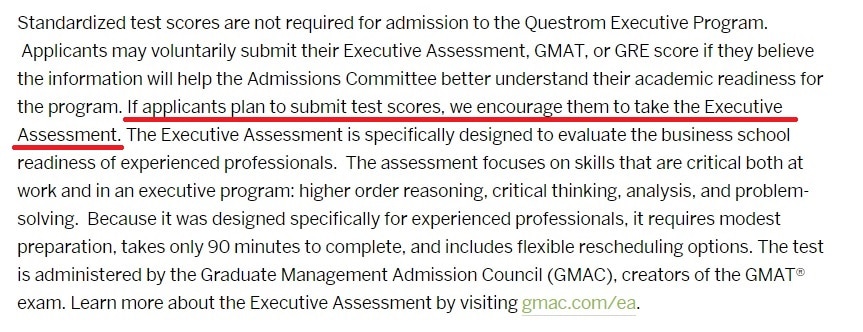
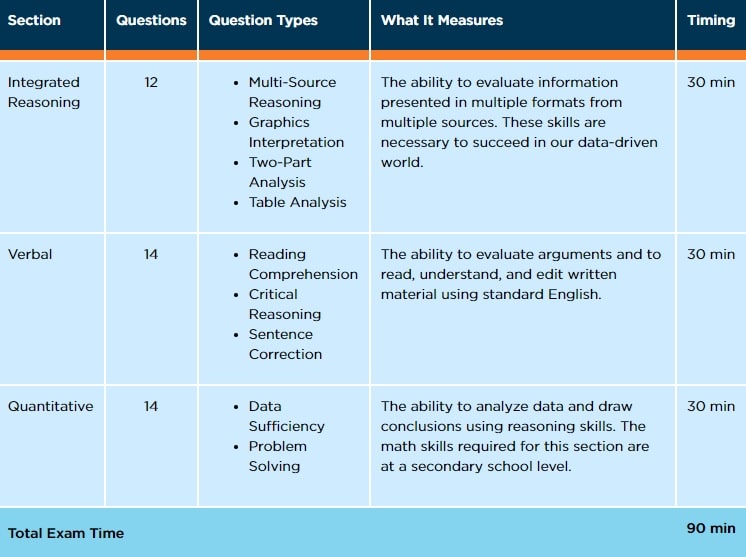
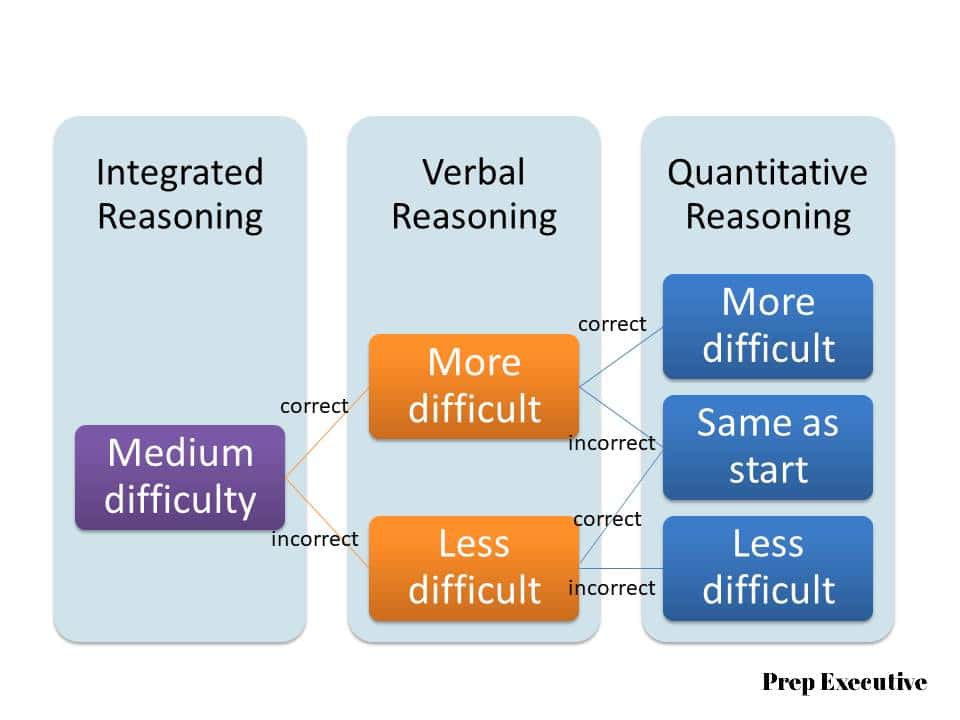

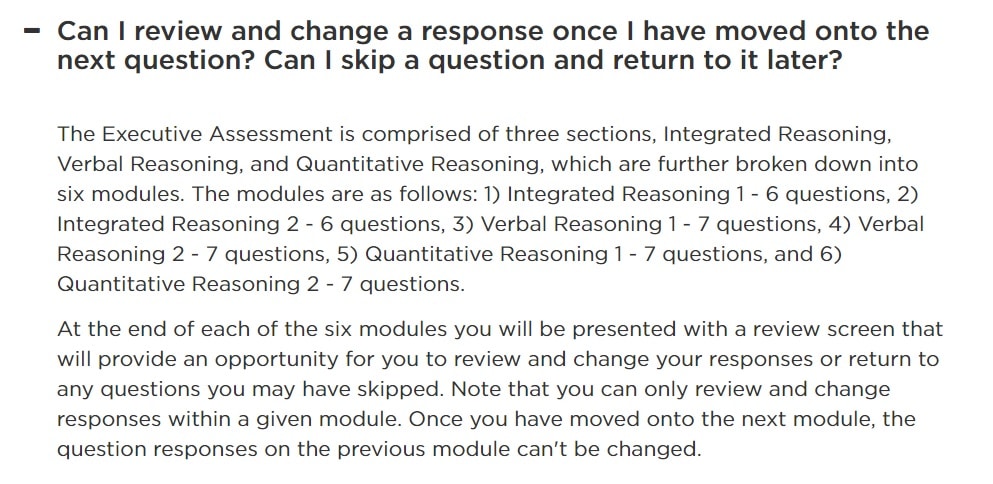
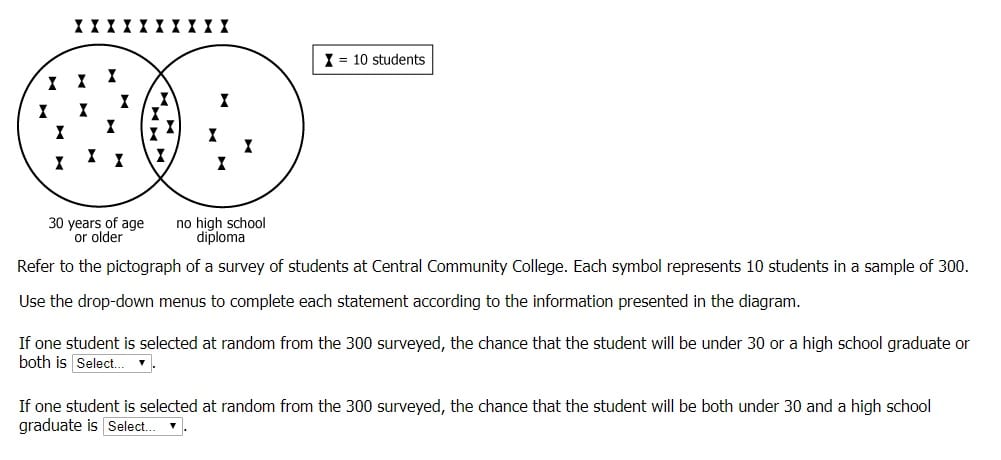
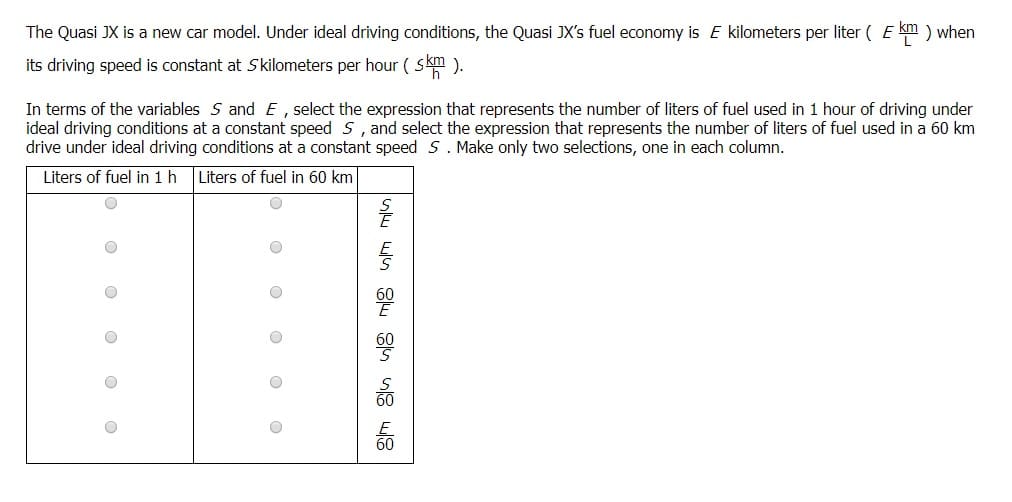

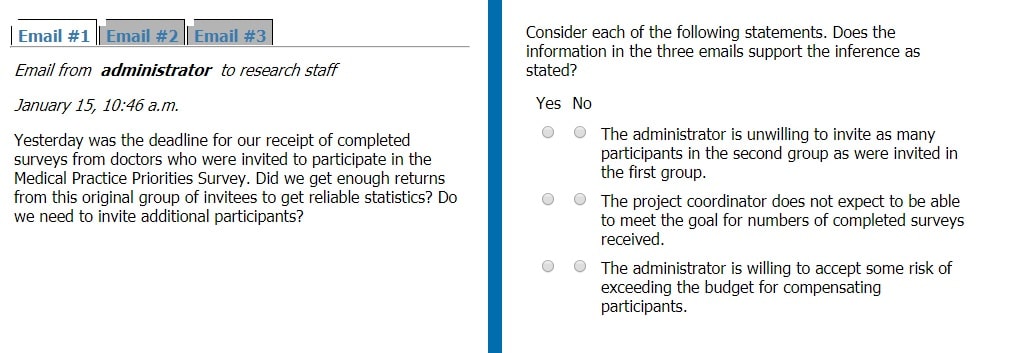

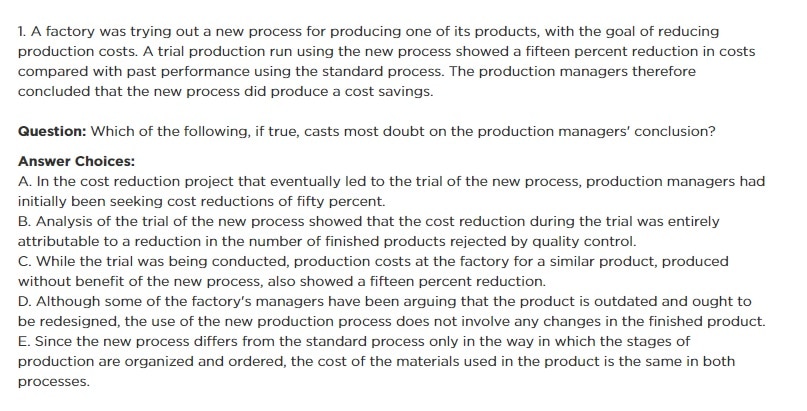


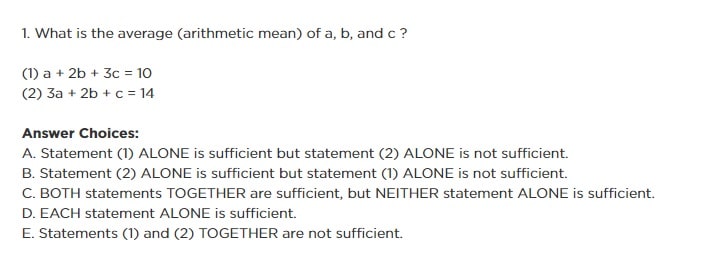
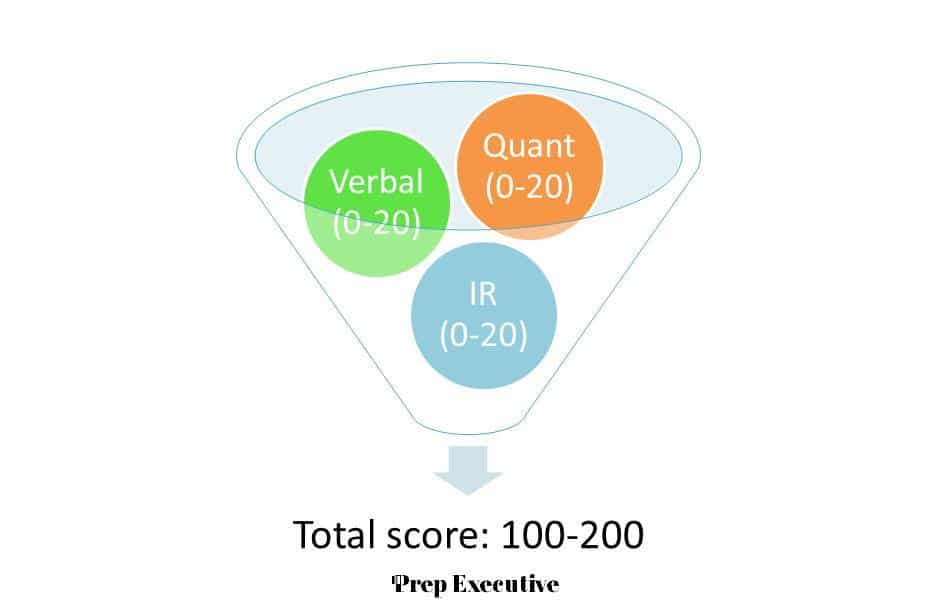







Hello. I have checked your prepexecutive.com and i would like to know if we will see all question types.
Hi DB,
Thanks for your question. You will see all the questions types on the exam as a whole. However, you may not see all math concepts tested on the quantitative section. For example, you test may not have any work or ratio problems, even though they are listed as possible concepts. I hope this answers your question.
Happy studying,
Eden
Hi, does the intergrated reasoning count the same number of points in the scoring?
Hi Chantal,
Thanks for your question! The integrated reasoning section does have the same weight as the verbal and quantitative sections. This equality is a big difference from the scoring of the GMAT, for which the IR receives its own score outside of the overall composite score. Good luck! Eden
is the order IR, verbal, quant always?
Hi Neil,
As of 2020, the order is always IR, verbal, quant. Although the GMAT does not allow test-takers to choose their test order, the EA does not.
Good luck!
Eden
Thanks so much! I had been looking for a comprehensive overview
Hi Mort, thanks for your comment!
Are any full-time MBA programs accepting the EA?
Hi Obdulia,
Thanks for your comment. Some full-time MBA programs have started to accept the Executive Assessment. Check out our list here for the exact programs:
https://prepexecutive.com/do-full-time-mba-programs-accept-the-executive-assessment?
Good luck!
Eden
Dear Prep Executive Agents,
Does each module of the verbal section have a reading comprehension passage? If so, does it mean that in each verbal module the test has 2 CR and 2 SC questions?
Kind regards,
Manuel
Hi Manuel,
Thanks for your question. Each module of the verbal section does not have to have a reading comprehension passage. Moreover, each verbal module does not have to have 2 CR and 2 SC questions. In fact, the number of RC questions with each passage is not standardize. Neither is the number of CR or SC questions in each module.
Although the verbal section is split into 2 modules, they are not mirror images of each other.
Hope this helps!
Eden